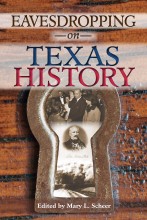
Eavesdropping on Texas History asks historians what events they would liked to have personally witnessed (University of North Texas Press)
What moment in Texas history would you have liked to have witnessed—to have been a fly on the wall—and why?
Dr. Mary L. Scheer, a Lamar University history professor, thought it made an interesting question. She reached out to fellow professors and Texas historians, which included former historical association presidents and/or fellows, but all of whom were experts in their various specialties. They wrote essays answering the question, and Scheer compiled them into an interesting anthology, Eavesdropping on Texas History.
The University of North Texas Press released the book this month.
Given that the book’s contents were prepared by professors, one might think that the tone of the book is professorial (pun intended), and not for the general reader. This book, however, was envisioned and produced with the idea that history can be both academic and fun.
It delivers on both counts. The essays are properly cited, as one would expect from a well-written research paper. Yet they are also engagingly written. The professors show that they’re good storytellers.
The “fly on the wall” question becomes an interesting exercise for Texas history for two reasons. First, Texans—and many others—are aware of the state’s unique and colorful history. Second, that history gives us many possibilities to consider.
Essays include:
- Watson Arnold, a TCU a adjunct history professor, wrote about the fall of the Alamo.
- Light T. Commins, an Austin College history professor, wrote about the controversial 1944 firing of University of Texas President Homer Price Rainey.
- Michael Collins, a Midwestern State University retired history professor, wrote about Lyndon B. Johnson’s first 24 hours as president, following the assassination of John F. Kennedy.
Not all of the essays capture high-profile moments. Nancy E. Baker, a Sam Houston State University associate history professor, wrote about the passage of the Marital Property Act. The act was signed into law in 1967 by then-Governor John B. Connally. It granted married women legal equal rights with their husbands. Under this law, married women could control their own earnings, including the right to sell their own property and sign their own contracts. This had not been the case in Texas before the law was enacted.
Scheer herself wrote about a poignant moment from over a century earlier. In 1861, Texas seceded from the United States to join the Confederacy. Sam Houston was governor at the time. He had failed to convince his fellow Texans to remain with the Union. Now, with Texas seceding, all elected officials were expected to swear an oath of loyalty to the Confederacy. Houston refused, and relinquished the governorship.
So, given the chance, where would you liked to have been, as a fly on the wall, for a moment in Texas history?
For me, I suspect I’d have liked to have sat in the Menger Hotel bar, in San Antonio, watching Theodore Roosevelt recruit the men who became the Rough Riders. This would have been in 1898. (You can still have a drink at the bar, which has some Roosevelt paraphernalia on display.) Or, it would have been fun to have attended the first game at the Astrodome, in April 1965, an exhibition in which the Astros defeated the New York Yankees. Given what has become of the Astrodome, it would be nice to remember it in its heyday.
This is an excellent book, and well worth reading.
